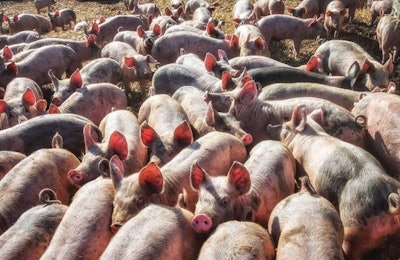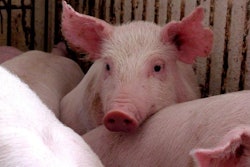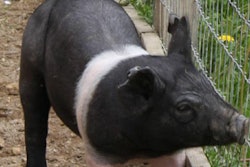
Sow housing will be based in part upon the feeding system utilized, for example, with electronic sow feeding (ESF) and larger pens with specific fencing layouts required to house 60-80 sows/station. In general, housing can be divided into either fully open or partial stall access. For the purposes of this article only typical indoor housing systems will be described.
Partial stall access
In some cases stalls are provided, either open-backed or free-access locking stalls (that close behind the sow upon entering and open again only when the sow backs out), so that the sows may choose whether to mingle in an open communal space or have the relative privacy of a stall for eating or lying down. Typically, if using free-access stalls, one stall must be provided for every sow to allow all to eat at the same time.
Free access stall pens are typically divided into either an ‘I’ configuration consisting of an open-slatted alley of 3 feet (.9 meters) to 10 feet (3 meters) behind the stalls or a “T” configuration with an alley behind the stalls leading down to a solid-floored open resting area, which may be deep-bedded. Alley widths in “I” pens have been tested at widths of 3 feet (.9 meters), 7 feet (2.1 meters) and 10 feet (3 meters) to determine what effect, if any, the size of open space had on sow activity and comfort. One study published determined there to be minimal differences between widths on production and physiological responses.
It showed no difference in aggression among sows between widths, nor litter size nor other productivity measures. The sows in stalls with a 3 foot (.9 meter) alley used the alley space less than those housed with wider alleys and had fewer interactions. The 3 foot (.9 meter) width did negatively impact the sows’ ability to turn around, a measure of animal welfare.
Fully-open pen design
In a fully-open pen design, no full stalls are provided. Open pens can be designed with either separate sleeping/lying areas (typically solid floored, either concrete with half-wall dividers or deep-bedded with straw) or fully-slatted with no special lying areas called out. Drop feeding can be onto solid pads with no divisions or with short, quarter-stall solid dividers to prevent eye contact between feeding sows.
Space considerations
The amount of floor space to allocate per sow/gilt is a matter of no small debate and usually rises quickly to the front of any discussion regarding loose-housed sows as it has one of the easiest-to-quantify economic impacts on an operation. In practice, sow area has varied from 15 square feet (1.39 square meters) to 38 square feet (3.5 square meters) per sow. While there may be no consensus among producers today regarding the optimum floor space allocations, there are a number of references available, whether through published legislative guidelines, scientific examples or producer best practices that will be referenced herein. Much will be based on the systems selected above for feeding, bedding and housing the sows, as well as the breed temperament of producers’ individual sow lines. The following are some tips, notes and findings about floor space:
- A large (70,000 or more sows) U.S.-based producer has historically always housed sows in groups of five in an 8 foot by 10 foot fully-slatted pen (16 square feet per sow) and has always shown very good production numbers. They are big proponents of individual sow attention and hand-feed their pens. They have been using this system since 1989.
- A prominent ESF manufacturer recommends a minimum of 24 square feet (2.23 square meters) per sow, 60 percent of which should be solid floored laying area.
- The UK, which has been stall-free since the late 1990s, recommends between 24.76 square feet (2.3 square meters) and 31.22 square feet (2.9 square meters) per sow in pens with or without free access stalls, although RSPCA guidelines call for 37.6 square feet (3.5 square meters) per sow. This number (3.5 square meters per sow) has also been cited as a good stocking rate for a separate pen specifically used to mix groups for the first 24 hours before placing the mixed group into the standard pen. The mixing pen allows more fleeing space and feed and water access to minimize aggression during the critical first 24 hours of a new groups’ formation.
- The common wisdom of larger is better does come with the caveat that having too large of a lying area leads to dunging on the lying floor as opposed to in the dunging area of slatted flooring. A 2 inch (5 centimeter) step-down from the lying area to the slatted dunging area is recommended to minimize soiling of the lying area, along with a minimum width of the slatted floor of 8 feet (2.4 meters). Slot width of slats should be no more than 3/4 inches (2 centimeters) with well-rounded edges.
Additional management considerations
Here a some further tips from producers and researchers covering a broad range of topics to assist in making loose housing of dry sows work:
- Adding hanging partition walls (hanging rubber mats or colliery belting) can reduce aggression by providing hiding places for sows being pursued.
- Mix sows towards the end of the day, immediately before lights-out — full, calm sows in a dark environment are less aggressive.
- Introduce more than three sows/gilts at a time into the main group, regardless of the size of the main group, to reduce singling out of any one new entrant.
- If introducing gilts to a group, make sure to pre-introduce the gilts to each other for at least 24 hours — gilts are extra-excitable and need time to familiarize with each other prior to joining a group.
- The use of sedatives (e.g., amperozide) seems to merely delay aggression, not prevent it.
- Some lines, or at least some batches within some lines, of breeding stock tend to be more flighty than others, and docility is a blessing in pen gestation.
- A producer in Michigan says that removing the boss sow tends to be less effective at preventing aggression versus removing the timid sow undergoing abuse.
- Current legislation in the U.S. allows sows to be kept in stalls for 28-35 days post-breeding. While there have been some studies showing no loss of reproductive performance from sows moved into pen gestation prior to this time most of the articles cited herein recommended against this practice until further research and documentation have occurred.
- Diet and floor space seem to be connected, with high-fiber diets combined with optimal floor space resulting in better reproductive performance. One study showed best results from a high-fiber, floor-fed diet in sows housed at 18.3 square feet (1.7 meters squared) per sow.
- Careful design of ESF pens with respect to location of feeders, watering and alley size is important as most aggressive behaviors in ESF pens are seen at the entrance to the ESF station.
- In deep-bedded pens, one prominent pig expert recommends against including divisions in the laying areas as the divisions tend to hinder the natural grouping of resting areas by the various sub-groups of sows in the pen.

















